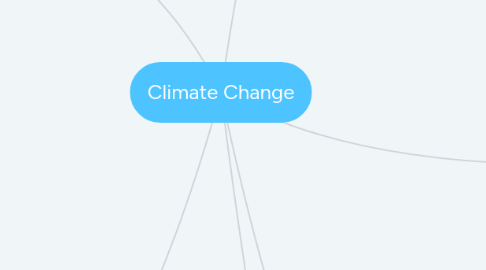
1. Natural Causes
1.1. Short term
1.1.1. Volcanic Eruptions
1.1.2. Changes in Ocean Currents
1.1.3. Changes in Air Currents
1.2. Long Term
1.2.1. Continental Drift
1.2.2. Sun Heating
1.2.3. Changes to Earth's Orbit
1.3. Feedback Loops
1.3.1. Positive
1.3.1.1. Definition: Amplify the original conditions
1.3.1.2. Examples
1.3.1.2.1. Albedo Effect: Ice melts, reflecting less radiation making it warmer making more ice melt. This process also happens in reverse
1.3.1.2.2. High temperatures create water vapor, a greenhouse gas, which increases temperatures further
1.3.2. Negative
1.3.2.1. Definition: Decrease the original conditions
1.3.2.2. Examples
1.3.2.2.1. Cloud Cover: Warm temperatures create water vapor, creating clouds, which reflects more radiation, making the temperature cooler
1.4. Greenhouse Effect
1.4.1. Definition: When energy is kept near the earth instead of being emitted into space
1.4.2. Greenhouse Gasses
1.4.2.1. Carbon Dioxide
1.4.2.2. Water Vapor
1.4.2.3. Methane
1.4.2.4. Nitrous Oxide
1.4.2.5. Stratospheric Ozone
1.4.2.6. Definition: Gasses that allow electromagnetic radiation from the sun to pass through more easily than infrared radiation from the Earth, therefore contributing greatly to the greenhouse effect
2. Accelerate
3. Human Causes
3.1. Animal Farming
3.2. Deforestation
3.3. Man Made Emissions
3.3.1. Vehicles
3.3.2. Factories
3.3.3. Burning Fossil Fuels
4. Contribute Towards
5. Create
6. Weather and Climate
6.1. Weather
6.1.1. Definition: Atmospheric conditions in a particular region over a short period of time.
6.1.2. Includes
6.1.2.1. Termperature
6.1.2.2. Percipitation
6.1.2.3. Wind Speed
6.1.2.4. Humidity
6.2. Climate
6.2.1. Definition: Average of the weather in a region over a long period of time
6.2.2. Determining Factors
6.2.2.1. Latitude and Longitude
6.2.2.2. Ocean Currents
6.2.2.3. Tilt of the Earth
6.2.2.4. Land Formations
6.2.3. Climate Zones
6.2.3.1. Different Areas Determined solely by their climate
6.2.3.2. Ecoregions
6.2.3.2.1. Determined by climate as well as the ecology of the region. i.e plants and animals that live in the region
6.3. Climate System
6.3.1. Lithosphere
6.3.1.1. Stone surface of the Earth that absorbs heat
6.3.2. Hydrosphere
6.3.2.1. Bodies of water and ice on Earth. Water absorbs heat while ice reflects it.
6.3.3. Atmosphere
6.3.3.1. Troposphere
6.3.3.2. Stratosphere
6.3.3.2.1. Ozone Layer
6.3.3.3. Mesosphere
6.3.3.4. Thermosphere
6.3.3.5. Exosphere
7. Evidence it Exists
7.1. Ice Cores
7.1.1. Density of the ice in different layers indicates change in climate
7.2. Tree Rings
7.2.1. Size of the tree rings change year to year depending on climate/growing conditions
7.3. Sediment in Caves
7.4. Recorded Weather and Climate Data
7.4.1. Shown increase in global temperatures since the industrial revolution
7.5. Increased Sea Levels
8. What We Can Do
8.1. Globally
8.1.1. United Nations
8.1.1.1. Initiative to keep global warming to a maximum of 1.5 degrees
8.2. Nationally
8.2.1. Fund technologies that make using green energy convenient and making green choices convenient as well
8.2.2. Carbon taxes
8.2.2.1. Reduce greenhouse gas emissions
8.3. Provincially
8.4. Individually
8.4.1. Eat less meat
8.4.2. Recycle
8.4.3. Buy fewer products that require many greenhouse gasses to be built
9. Impact
9.1. Global
9.1.1. More Floods
9.1.2. More Droughts
9.1.3. Increase In Violent Storms
9.2. National
9.2.1. Longer Growing Season
9.2.2. More Heat Waves
9.2.3. Melting of Ice and Increased Sea Level in the Arctic
